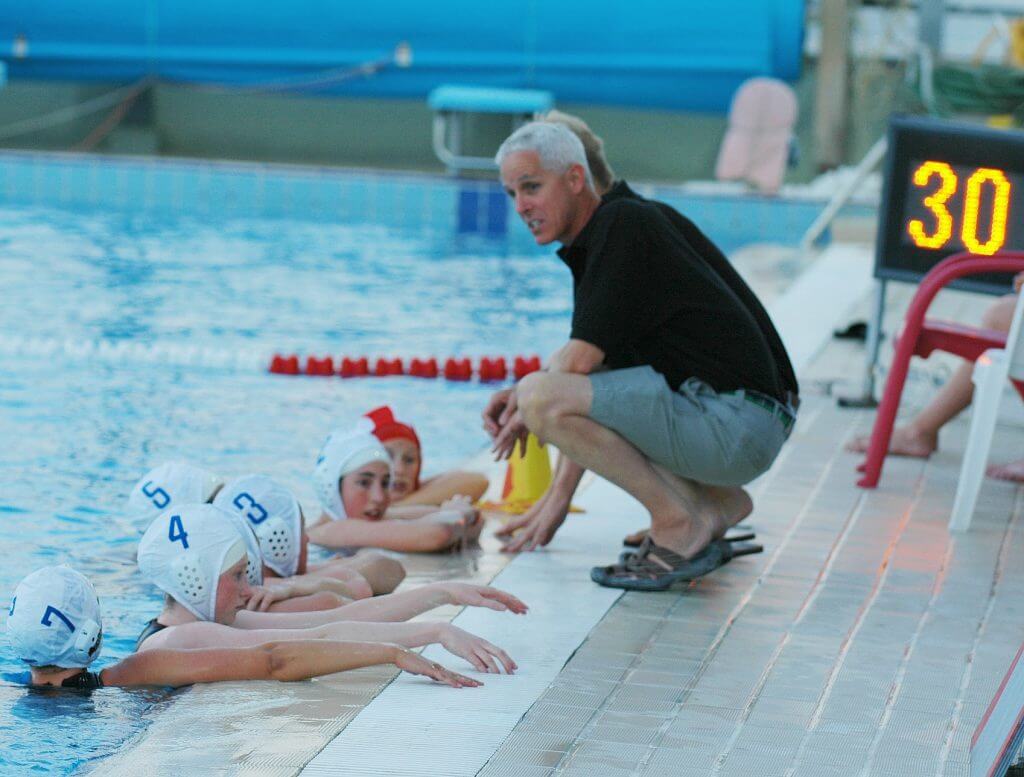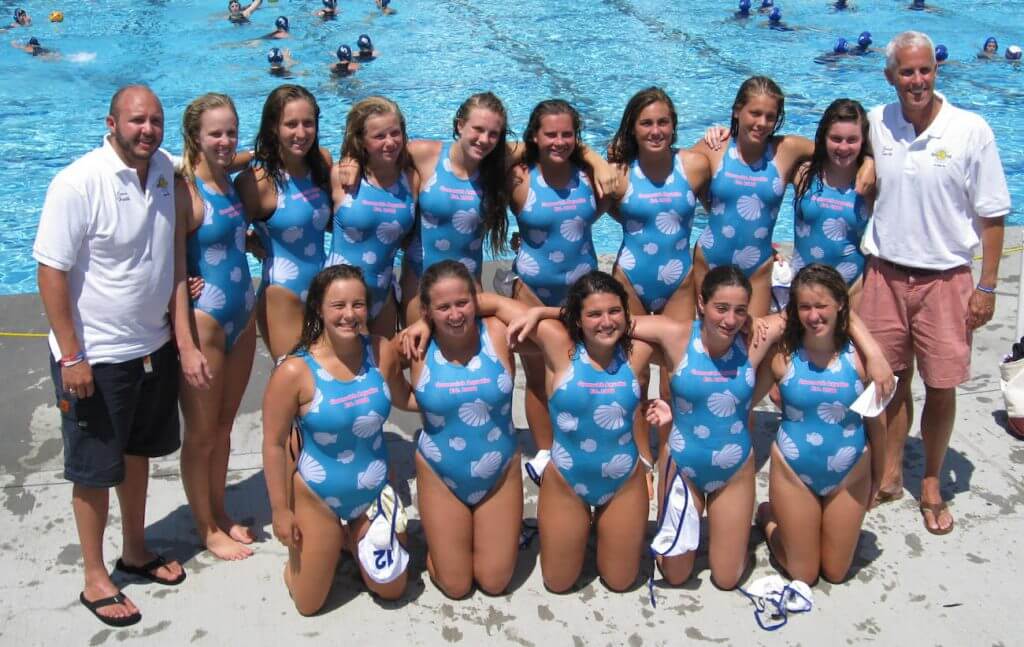Catching Up with Bill Smith of Greenwich Aquatics

BY Michael Randazzo, Swimming World Contributor
The 2017 Junior Olympics Northeast Zone Qualification (NEZ)—held last weekend in Greenwich—was yet another example of how this tony Connecticut community has become the epicenter for East Coast water polo. At the Greenwich YMCA’s Olympic-sized pool, 42 teams from Connecticut, Maryland, New Jersey, New York and Pennsylvania competed in five different age groups to qualify for the 2017 Junior Olympics Water Polo Tournament in Irvine, CA
NEZ JO’s were overseen by Greenwich Aquatics, which oversees one of the region’s largest age group programs. The brainchild of Bill Smith, a USA Water Polo at-large board member, Kim Tierney Wang, Director of Operations, and Head Coach Ulmis Iordache, Greenwich Aquatics is now the envy of clubs throughout the country.
With consistent success in some of America’s most prestigious tournaments, and a track record of developing players who compete at the sport’s highest level—including Thomas Dunstan, a member of the U.S. National Men’s Team that competed in the 2016 Rio Olympics—Greenwich competes with and often beats the top California clubs.
Smith, who has spent that past two decades growing the sport in the Nutmeg state, is a graduate of Villanova and the Wharton School of Business at the University of Pennsylvania. He began organizing age group polo in 2000 with the Greenwich Youth Water Polo Club where his son Will and daughter Patty competed before going on to play for Stanford and Harvard respectively. In 2008 he partnered with the Greenwich YMCA to launch Greenwich Aquatics, sparking impressive growth of the sport in the Northeast.
Smith recently spoke to Swimming World about polo’s development on the East Coast, the challenges of competing out West, and his dedication to building a strong foundation to expand water polo throughout the country.
What is your history with East Coast youth polo and the Junior Olympics?
Way back in the day, the only age group club from the East Coast that went to Junior Olympics was the Navy club under (Mike) Scofield and Mladen (Stanicic) and others that were around at that time, including Carl (Quigley). Mike was the zone chief at the time.
I started the Greenwich Water Polo Club [in 2000]. We saw dramatic growth right from the beginning and within three years were up to 270 kids. Wilton High School’s coach Brooks Ensor was doing a great job, my kids played for him before they [joined] what we used to call Greenwich Youth Water Polo. Then we moved it to Greenwich Water Polo and now it’s Chelsea Piers.
I was the coach of the first team that we took out to JOs from Greenwich area in 2001. Years ago, Terry Lowe [former head coach at Greenwich High School] took his 18-U high school teams out there but that had been well over a decade ago.
I started with a 14-U girls team. They didn’t have the various levels and all the other stuff [they have now]. We finished where you finish when you’re first starting. The rule is that when you’re new you play like you’re new. And we were new.
Qualifying was never much of an issue because it was Navy and us. Navy was the steady force [attending] JOs with solid youth teams. I give a lot of credit to Mladen and Scofield. They were doing the college stuff and then to put so much energy into the youth side—it’s unbelievable. The physical effort, the pool time—they certainly are the role model for any collegiate coach to show what they can do at the age group level.
The early days rolled from there. When I took that first team out there were some people who discouraged us from going.
“I don’t think you should be going out to this thing because you know you’re going to lose by a lot and this is going to be humiliating for the kids,” they said. “They’ll drop out.”
I said: “Well, indeed the first year we’re going to be that way. By the second year we may even know who the teams are out there and by the third, fourth and fifth they may even know who we are.”
Now we go to JOs and it’s so funny, one of the [California] coaches came up and I said I’m from Greenwich, Connecticut. They said: “My gosh, Connecticut! That’s great! I’ve only been playing California teams. It’s so great that you guys are out here.”
I said: “Look, it’s no problem at all. I have someone in the stands who speaks fluent Californian. If we ever have any issues, we’ll be able to work this thing out.”
Everything’s outdoors in California. Here it has to be indoors if you want to do anything close to year-round. We’re out there and it was the 16-U girls’ the first year they had a gold division and we had just beaten Stanford A team and won a gold [2008]. It was a huge win with Taylor Dunstan—Thomas’s sister—who was on that team.
Here we are Connecticut, East Coast, and the response was: “You know, you guys are actually legit. But I have a question for you. Doesn’t it snow in Connecticut? How do you [play in the winter]?
They’re thinking outdoor pools.
“We come out with these mallets and hack off the top of the ice,” I said. “The kids go in there and after a couple of laps they’re good to go!”
And he said: “Really?!” I said: “No, not really!” [Laughs]
I end up pulling their leg all the time.
Now we’re really legit. We went out to the KAP7 Cup [last April] with sixty other teams and two of our age groups got first place and the 18-U girls got second. They know that the East Coast is coming on. I would say that the level of the East versus West has stepped up a lot.

2008 Greenwich Aquatics 16-U Team at Junior Olympics. Photo Courtesy: Bill Smith
To what do you attribute the growing respect Greenwich—and by extension East Coast—water polo is now gaining?
The fact of the matter is that our sport—much like lacrosse or soccer, is a team sport—and a big part of the learning is experiential. There’s an old saying in coaching: “Let the game be the teacher.”
As a coach you can’t set up a drill to teach a very specific thing that you may learn in one game situation. The better players that you’re playing against, they teach you. The more exposure that kids can get playing at a level that they’re challenged at, is really good.
The big disadvantage that we have—and it’s a longer-term process—is finding high-level competition [locally]. If you’re in California and you’re playing three games every single weekend and the competition level is good. They’re playing in an environment where if they’re not at their very best they’re going to lose.
[On the East Coast] any team that is going to win by 10 goals, it doesn’t help anyone—and it certainly doesn’t help the winner. They develop bad habits and then you worry about the losers. Are they going to be discouraged?
The more you’re doing that against higher level competition the better. That’s why California as a brand in our sport generally is considered another notch higher. That’s because the ecosystem they have is not replicated anywhere else in the U.S.
Is what you and others are building in Greenwich causing a ripple effect that raises the level of competition through the Northeast?
Without a doubt. And I certainly agree that the level in general is picking up. The main things that drive me are growing the sport and to bring it to a higher level. I would put that under the acronym of “growth with quality.”
Kim, Ulmis and I started Tri-State [an age group league for 12-U, 14-U and 16/U18-U] because we don’t have enough competition. As is often the case, Kim just went off and she did it. It’s her league—she’s great at executing.
We did that to get competition for our kids, and when it first started it was very lopsided. The problem we always had is you have the eight, nine, 10, 12 year olds and everyone had to travel down to Navy and spend a weekend to play three games. We wanted to have something that was more local to lower the barrier to entry so that teams in New York City, Pennsylvania, New Jersey and wherever could compete. Connecticut is close. You can come up for the afternoon and be back home for dinner.
It’s all about getting more play time. Let the game be the teacher in different environments.
I know from when I played, I worked and trained harder when I knew there was a competition coming up. It’s the great motivator. And I do believe that it’s helped some clubs sustain themselves, saying: “We’re part of this league, now we’re going to be showing up every other weekend with a boys or girls’ team and compete.”
And then players start showing up for practice because they can see there’s a structure to it. It’s regular, close by, [and a] lower barrier to entry and more playing time.
How do you feel that competition at Tri-State and JOs remains balanced given player and parental expectations about winning?
Going back to my two benchmarks of growing the sport and increasing the quality, clearly there are disparities within our own zone. I would put the zone qualifier at a different level than you’d have at Tri-State, which is the work of the day. How do you get better, how do you move up those notches? It’s a progression; doing it all the time.
The number one thing we have to do as a club is to develop a water polo culture. That’s where young kids are looking up to older ones thinking: “This is something I really want to do.”
The bottom line on all this stuff [is]—all these other teams in the Northeast—we’re all brothers in the sport. The real competition, at least it is for us, is lacrosse, soccer, all these other sports that are capturing the attention of our kids. The youth sport market is extremely competitive.
We’re always trying to make our sport a better alternative, seen as having some cache.
The true competition isn’t at the JOs; it’s against the other types of sports.
If you can develop the culture… like when you go to Europe and on a Thursday afternoon you’re in Croatia and you’re playing on this makeshift field floating in the Adriatic Sea and all the neighbors pour out of the stores and they have drums and horns and they’re cheering it on… [you think]; “Wow, this is so amazing!”
At Junior Olympics when you’re playing in higher-level games and the whole crowd is going crazy and every single pass is important, every swim-off, every goal—it’s all so compelling.
When you get to another level where they all have some basics down but it’s the culture part of it where the players say: “This is something I really want to do.”



